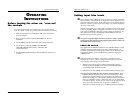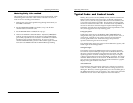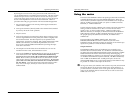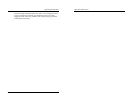
Operating Instructions
Multimix 12R Reference Manual 29
Proper gain staging of other equipment
The total noise performance of your system depends on proper gain
control of all the elements. A "noisy mixer" is usually a quiet mixer in a
system whose gain structure is incorrect. As a good starting point, set
most volume level controls of other equipment at 3/4 or 75% of full.
This will decrease the possibility of overload distortion and keep the
amount of background noise to a minimum.
Turn down amplifier levels: In particular, don't set the input controls
of a power amplifier "wide open" if you have to run the faders of the
mixer in the bottom half of the travel (and the meter of the Multimix
12R well below the "0" mark) to keep the system from being too loud
or feeding back. It's better to run the mixer at its normal level, and
turn down the amplifier's controls for the desired level. By turning the
amplifier's own volume controls down, you turn down the residual
noise of everything that precedes it in the signal chain, resulting in a
quieter, more controllable system.
However, if the mixer output is too loud, and the input stage of the
amplifier being used is an active circuit (instead of a passive voltage
divider type), it is possible to clip the preamp stage of the amplifier and
cause nasty distortion even if the amp level is low. Use good
judgment and consult the manual for your amplifier for more
information.
Distortion caused by EQ: If a large amount of EQ is used, it may
become necessary to decrease either the trim control, or the channel
fader, or both. The EQ is capable of adding quite a bit of gain and is a
frequent cause of overload distortion problems. The PEAK LEDs
monitor the signal after the EQ circuit, both pre and post fader.
Operating Instructions
AUX System: Effects Send/Receive
The AUX 2 buss of the Multimix 12R is a post-fader send. Usually, you
will connect AUX 2 to the input of an effect device. Using a post-fader
send means that when you fade a channel out, its effects will fade out
also.
Using the aux send allows each channel to have its own level control
feeding the aux output (and eventually the input of the effect device).
You can make a mix of any channels you want to go to the effects by
using the individual channels’ aux send levels.
But sending signal to the effect device is only half the story. To be
heard, the output of the effect device must be returned to the mixer
and turned up in the mix before you can hear it. You have two
options for returning the effected signal to the mix:
• connecting to the STEREO AUX RETURN jack, or
• connecting to the channel LINE IN or STEREO LINE IN jacks.
Connecting to channel inputs gives you the added bonus of panning
and EQ on the effects, and the ability to send a “wet” or effected mix to
AUX 1 for monitoring.
Wet/dry mix: No matter where you connect the output of the effect
unit into the mixer, you are in control of the “wet/dry” balance
between the mixer’s channel inputs (the uneffected or “dry” signal),
and the effect returns coming from the effect device (the “wet” signal).
The output of the effect device should only contain effected signal, and
not have any uneffected or "dry" signal mixed with it (since the dry
signal is already at the mixer). Consult the manual for the effect
device to find out how to set the effect so that only effected ("wet")
signal is returned to the Multimix 12R.
How to Set Aux Send and Return Levels
You must set correct levels on the mixer's individual Aux Sends and
STEREO AUX RETURN and the effect device's own controls to get
good, clean, quiet results.
✪ Improper level setting is the most common cause of noise and distortion
problems.


















